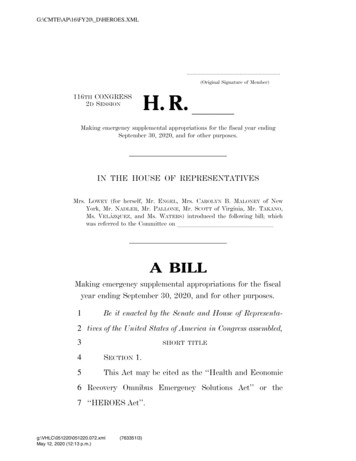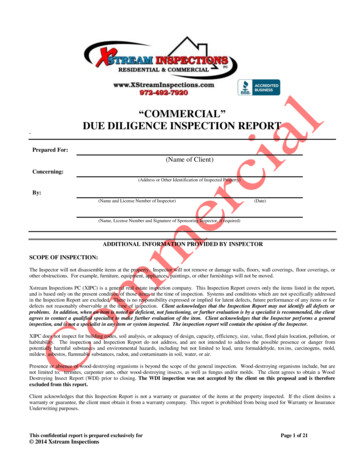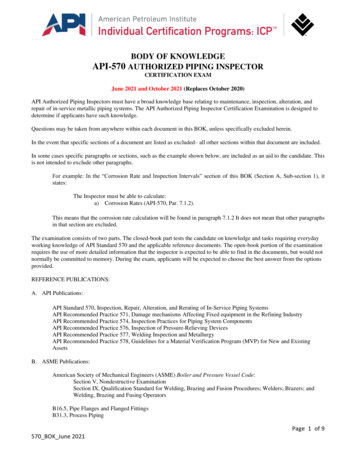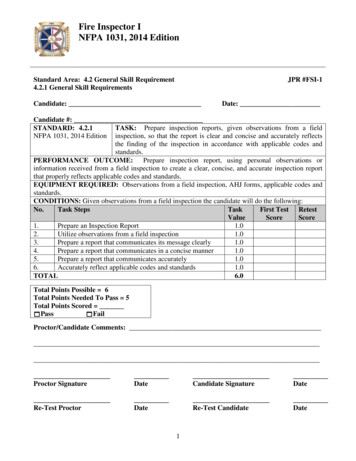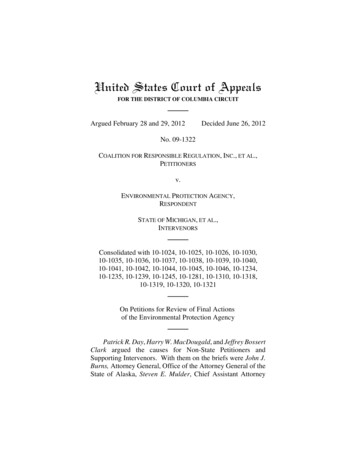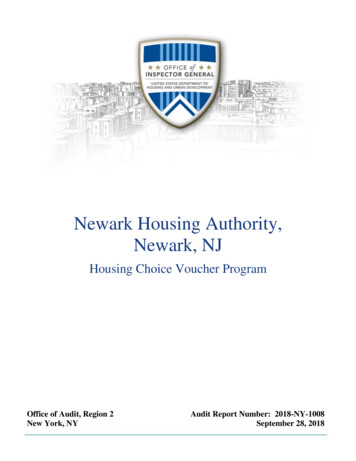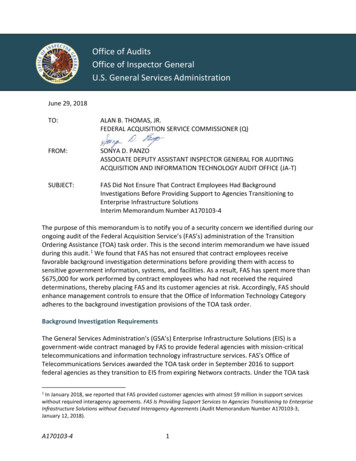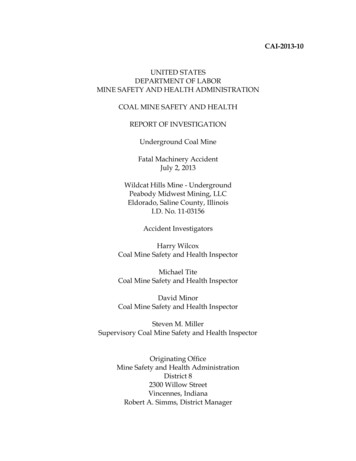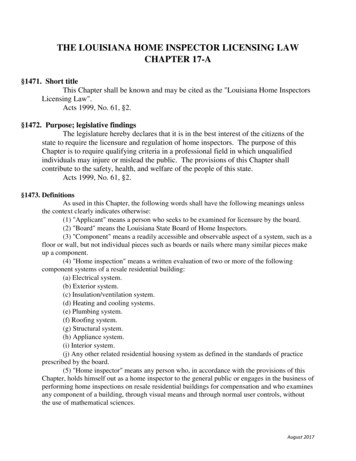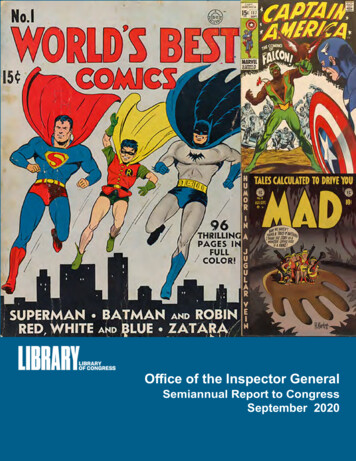
Transcription
Office of the Inspector GeneralSemiannual Report to CongressSeptember 2020
IN THIS SEMIANNUALREPORT TO CONGRESS.the Office of the Inspector General showcases acurrent exhibit at the Library of Congress, ComicArt: 120 Years of Panels and Pages currentlyposted online for viewing on the Library's website.*A number of the images are also featured in a priorpublication of Library of Congress Magazine fromSeptember/October 2017 – Comics! An AmericanHistory.The world of comic art offers a wide variety of visualand narrative storytelling styles that evolved frompanels in early newspapers to contemporary images.It delves into the world of superhero powers, butalso offers works of real people, rock stars, and evenpoliticians in the graphic form.Frank Miller once explained, "The illustrations are notreally illustrations of what's going on. The narrationisn't really describing what's going on, either. There'sa gap there, and somewhere in that gap is reality."Comic Art: 120 Years of Panels and Pages wasmade possible by the Swann Foundation. Copyrightsare used by permission and all featured works arefrom the collections of the Prints and PhotographsDivision and the Serial and Government PublicationsDivision at the Library of Congress.* Due to the coronavirus pandemic, all Libraryof Congress buildings and facilities are closed tothe public, including exhibitions. This exhibit isaccessible online.Cover Images [Clockwise]: World’s Best Comics,no. 1. New York: World’s Best Comics Co., 1941.Copyright Permission DC Comics; Captain Americano. 117, Fall 1969. Copyrright Marvel; Mad, no. 6.New York: Educational Comics, Inc., August/September 1953. Copyright Permission E.C. Publications, Inc.This page and Following Page: Spider-Man! fromAmazing Fantasy No.15. Copyright permissionMarvel.
September 30, 2020Message from the Inspector GeneralUnder Librarian Carla Hayden’s leadership, the Library took steps this semiannual periodto preserve traditions and prepare for the future, while concurrently responding to ahistoric challenge. The COVID-19 coronavirus pandemic had an enormous impacton our lives, and yet the Library stayed true to its mission – Engage, inspire, and informCongress and the American people with a universal and enduring source of knowledge and creativity.The Library demonstrated its commitment to purpose with the 20th annual NationalBook Festival held virtually for the first time in late September. The novel coronavirusmade it impossible to hold an in-person festival as usual given the need to ensure socialdistancing. Nevertheless, the festival included book talks across multiple genres —more than 120 writers, poets, and illustrators presented — and audience members hadopportunities to address questions to authors. The U.S. Copyright Office also had its150th anniversary, and Librarian of Congress Carla Hayden announced her selectionof Shira Perlmutter as the 14th Register of Copyrights. Since its establishment, theOffice has provided critical services, helping copyright owners protect their worksand preserving a public record of the country’s creativity.During this semiannual period, we issued several financial statement-related audits, anevaluation on the Financial Management and Reporting top management challenge, andan audit on the Contracting top management challenge. As part of the Contractingaudit, we determined that the Library’s Contracts and Grants Directorate (CGD)reached an important milestone. CGD created a plan following good business practicesand made significant progress in addressing operational, human capital, and internalcontrol weaknesses to the extent that it merited removing the procurement functionfrom our list of the Library’s Top Management Challenges.The Library implemented eighteen of our recommendations from prior semiannualperiods. Nine of the recommendations are not identified here because they were inreports not released publicly.Kurt W. HydeInspector General
Table of ContentsProfiles .1Top Management Challenges .5Audits, Evaluations, and Reviews .9The Library Continues to Face Challenges Ensuring EffectiveFinancial Management and Reporting .9Results of the Library of Congress' FY 2019 Financial Statements Audit .9Results of the Library of Congress' FY 2019 Fiduciary Fund FinancialStatements Audit.10Follow-up Audit of the Contracts and Grants Directorate.10Other Audits Division Activities .11Review of Legislation and Regulations . 13Investigations Division . 15Other Investigations Division Activities .17Unimplemented Recommendations . 19Implemented and Closed Recommendations .29Unimplemented Financial Statements Recommendations .31Reporting Requirements .33Peer Review Reporting . 36Office of the Inspector General Organizational Chart . 37Office of the Inspector General Hotline . Inside Back Cover
ProfilesLibrary of CongressThe Library is the research and information arm of the United States’ national legislature and the world’s largest knowledge reserve. The Library’s mission is to engage,inspire, and inform Congress and the American people with a universal and enduringsource of knowledge and creativity. This mission is accomplished through the workof approximately 3,200 permanent employees.Founded in 1800, the Library is also the nation’s first federal cultural institution, holdingmore than 167 million physical items on approximately 838 miles of bookshelves.These items include books and other print materials, recordings, photographs, maps,sheet music, and manuscripts. The Library occupies three buildings on Capitol Hilland Taylor Street Annex in Washington, DC and the Packard Campus of the NationalAudio-Visual Conservation Center in Culpeper, Virginia. In addition, the Libraryoperates six overseas offices and stores collections material in purpose-built facilitiesin Maryland.1The Library has six primary components: Office of the Librarian Chief Operating Officer Service Unit Office of the Chief Information Officer Library Collections and Services Group, which manages three traditionallibrary operations: Law LibraryLibrary ServicesNational Library Service for the Blind and Print Disabled U.S. Copyright Office Congressional Research ServiceThe Office of the Librarian provides leadership and executive management to theLibrary, overseeing the implementation of the Library’s mission. It includes the PrincipalDeputy Librarian, the Office of Communications and External Relations, and theOffice of the Chief of Staff. The Office of the Chief of Staff includes two centersthat focus on user engagement and fostering access to the Library’s collections forresearch, teaching, and visitor education: the Center for Exhibits and Interpretationand the Center for Learning, Literacy, and Engagement.1Additionally, the Library has materials stored (per interagency contracts) in Cabin Branch andLandover, Maryland and Pittsfield, Massachusetts as well as per contract in Fredericksburg,Virginia. The Library also has materials stored in its overseas offices.1 SEMIANNUAL REPORT TO CONGRESS
The Chief Operating Officer Service Unit manages and administers the Library’snon-information technology infrastructure functions and daily operations, includingoversight of the Human Capital Directorate, the Financial Services Directorate, theContracts and Grants Directorate, the Integrated Support Services Directorate, theSecurity and Emergency Preparedness Directorate, and Library Enterprises that operateon a cost recovery basis.The Office of the Chief Information Officer has agency-wide responsibility overall aspects of managing Library digital strategy and IT strategies and resources. Thisincludes development and implementation of the Library of Congress IT strategicplan, guiding Library leadership on digital futures, advising on the technology market,and serving as a solution broker for the agency. It also includes assessing, designing,developing, maintaining, standardizing, optimizing, and protecting the Library’s ITresources. IT resources include all Library budgetary, personnel, equipment, andfacilities resources and services that are primarily used for the management, operation,acquisition, disposition and transformation or other activity related to the lifecycle ofIT. The Library’s digital collections content is managed by the appropriate serviceunit with statutory or curatorial responsibilities for a given collection.The Library Collections and Services Group (LCSG) oversees units responsible foracquiring, stewarding, describing, and serving Library collections and manages fellowships and internships. The LCSG includes: the Law Library, which assists Congressand the legislative process by providing comprehensive research on foreign, comparative,international, and U.S. law and other legal reference services; Library Services, whichperforms the traditional functions of a national library, such as acquisitions, cataloging,preservation, and reference services for both digital and conventional collections andoperates the National Audio-Visual Conservation Center and the American FolklifeCenter, among other programs; the National Library Service for the Blind andPrint Disabled, which is a national program that circulates books and magazines inbraille and audio formats to people with temporary or permanent low vision, blindness, or a physical disability that prevents them from reading or holding the printedpage; and the John W. Kluge Center, which brings together the world's best thinkersto contribute to the conversation about the challenges facing democracies in the 21stcentury through residential fellowships, lectures, and other research opportunities.The U.S. Copyright Office administers the nation’s copyright laws for the advancement of the public good, offers services and support to authors and users of creativeworks, and provides expert impartial assistance to Congress, the courts, and ExecutiveBranch agencies on questions of copyright law and policy.The Congressional Research Service supports the legislative process by providing,exclusively to Congress, objective, confidential, and nonpartisan assessments of publicpolicy issues and legislative options for addressing those issues.SEPTEMBER 2020 2
Office of the Inspector GeneralThe Library’s Office of the Inspector General (OIG) was established in 1988 as anon-statutory office deriving its authority from the Librarian of Congress. OIGbecame statutory with the passage of the Library of Congress Inspector General Act of 2005(2 U.S.C. § 185), with a mandate to independently: conduct and supervise audits and investigations of fraud, waste, and abuserelating to the Library; lead, coordinate, and recommend policies to promote economy, efficiency,and effectiveness; and keep the Librarian of Congress and the Congress fully and currentlyinformed about problems and deficiencies relating to the administrationand operations of the Library.At the end of 2019, the Library of Congress Inspector General Act was amended for thefirst time since its enactment, giving the office, increased parity with Executive BranchIGs, statutory law enforcement authority, and defined independence with respect tobudget and hiring.Through the Council of Inspectors General on Integrity and Efficiency (CIGIE), weare part of a community of Inspectors General, who collectively oversee operationswith the Executive and Legislative branches. In the years to come, we look forward tocontinuing our efforts to provide independent and effective oversight, such as throughour Semiannual Reports to Congress as required by the Inspector General Act.Every six months we provide Congress with this report detailing our independentoversight of the Library. The semiannual report presents information on: the Library’s top management challenges; significant audits, investigations, and other activities of the OIG; OIG’s review of legislation and regulations affecting the Library; and Library decisions on OIG recommendations and the status ofimplementation, along with any resulting monetary benefits.WONDROUS WOMENOF COMICSA curator's picks:Library Serials Reference Specialist and Kluge Staff Fellow, Megan Halsbandshares a few of her favorites from the Library's collections of over 140,000comic books. Originally appeared in the Library of Congress Magazine September/October 2017 edition.(see following pages 4 - 7)3 SEMIANNUAL REPORT TO CONGRESS
1.2.The Audits Division conducts in-depth reviews that address the efficiency, effectiveness, and economy of the Library’s programs, activities, and functions; providesinformation to responsible parties to improve public accountability; facilitates oversight and decision-making; and initiates corrective action as needed.The Audits Division also contracts with an independent public accounting firm thatexamines whether financial statements fairly present financial positions, results ofoperations, and budgetary resources. The firm also assesses whether the Library andother entities have adequate financial reporting internal control systems that complywith applicable laws and regulations. OIG reports are available at www.loc.gov/about/oig.The Investigations Division addresses alleged or suspected wrongdoing by agencyemployees, contractors, or others responsible for handling federal resources. Violations of Library regulations or fraud committed against the Library can result in administrative sanctions and criminal or civil prosecution. Contact information for theOIG Hotline is located on the inside back cover of this report.SEPTEMBER 2020 4
Top Management ChallengesOIG assesses certain top management challenges for each semiannual report. Forthis report, we assessed Contracting. The Library has six other top managementchallenges: Strategic Planning and Performance Management. Many of the Library’smanagement challenges over the years have flowed from a historic lack ofproper strategic planning and performance management. Digital Strategic Planning and Execution. A more strategic approachto digital services and collections is necessary because of the pace of digitalinnovation and the need for the Library to act on many fronts to execute atimely and cost-effective digital transformation. IT Modernization. The key to the Library successfully developing amodern IT environment is the Office of the Chief Information Officer(OCIO) using a strategic approach to improve its IT governance, establishing accountability for IT investments, implementing well-designed,secure, and business-driven networks and computing facilities, andemploying IT best practices. Collection Services Workflow. The Library needs to broaden its capabilityto perform end-to-end monitoring of its collections services workflow inorder to better manage its arrearage and number of items collected andstored. We identify Library Services' collections storage activities as beingpart of a supply chain of processes that include selection, digitization,preservation, and storage services, among other processes. U.S. Copyright Office's Modernization Program. In fiscal year (FY)2018, OCIO and the U.S. Copyright Office (USCO) initiated a joint effortto develop a future-state version of USCO's IT system as part of USCO'slarger modernization program. The program poses a top managementchallenge because of the complexity, magnitude, and importance of theprogram to fulfilling USCO's mission. Financial Management and Reporting. A reliable system of internalcontrols over financial reporting is vital for an agency to accurately andreliably report on its financial transactions and position. We are monitoringthe Financial Services Directorate’s progress in strengthening its financialmanagement and reporting processes.CONTRACTINGThe procurement function managed by the Library’s Contracts and Grants Directorate(CGD) in the Chief Operating Officer (COO) service unit has been a long-standingtop management challenge. However, in light of our recent review, we are pleasedto announce that we are removing it as a top management challenge. In recent years,5 SEMIANNUAL REPORT TO CONGRESS
3.4.the Library has made steady improvements in the contracting area. In our February2018 report – Incremental Improvement Has Been Made to Modernize the Office of Contractsand Grants Management – we found that Library management had made incrementalprogress but not attained a truly modernized operation, although CGD had a plan toimprove performance and address our audit findings and outstanding recommendations. In our most recent August 2020 report – Follow-up Audit of the Contracts andGrants Directorate – we determined that CGD created a plan following good businesspractices and had made significant progress in addressing operational, human capital,and internal control weaknesses to the extent that it merited removing the procurementfunction from our list of the Library’s top management challenges. In the following,we describe the steps taken by the Library to address our prior recommendations andreach this important milestone.Creating Strategic Goals and Performance MeasuresWe recommended that COO develop the strategies and tactics to accomplish short-,mid-, and long-term strategic goals for improving the procurement function alongwith valid and reliable performance measures. We also recommended that COOSEPTEMBER 2020 6
5.6.7.and CGD use the Project Management Institute’s Project Management Body ofKnowledge (PMBOK) best practices to develop and implement a project plan witha critical path for achieving the goals and addressing our past recommendations thatwere outstanding. In response, CGD created, or assisted in creating, several strategicplanning documents. For example, CGD’s Plan to Improve Contracting for FY 18 – FY 19(Plan) identified short-, mid-, and long-term goals, as well as performance measures,and COO’s April 2018 Project Plan for Acquisitions outlined CGD’s critical path to completing the remaining items in fulfillment of the goals.Creating and Implementing a Human Capital Workforce PlanWe recommended that COO work with CGD and the Human Capital Directorate(HCD) to develop a strategic workforce plan for the procurement function usingPMBOK's best practices and focus on improving human capital-related metrics, suchas reducing average vacancy terms and attrition. We also recommended that HCDexpedite its efforts to fill certain key CGD vacancies. In response, COO and CGDtook steps that represented the development of a strategic workforce plan with metricsand, with HCD’s assistance, filled the key vacancies.Strengthening Financial Management ControlsTo ensure the reliability and accuracy of contract and related financial data, we recommended a full evaluation of the internal control design of the Legislative BranchFinancial Management System’s (LBFMS) acquisition module; LBFMS is more7 SEMIANNUAL REPORT TO CONGRESS
commonly known as Momentum. Specifically, we recommended the developmentand installation of a daily automated reconciliation process for balancing contract/task order open obligations by number and amount between Momentum’s acquisition and financial modules. CGD performed the evaluation, which was part of anupdate to a prior analysis performed in November 2014; the analysis resulted in 22recommendations, six of which were specific to the module’s internal controls. CGDhas been working to implement them and we recommended that CGD continue withthese efforts. We also determined that the Financial Services Directorate was runninga daily automated reconciliation.Developing and Implementing a Quality Assurance ProcessWe recommended that CGD’s policies and procedures require quality assuranceprocesses for verifying that all systems are operating as designed and compliance isadequate. Specifically, we recommended that CGD obtain assistance from catalogingand systems experts within the Library to design and install a contract file management process that appropriately tracks contracts files. We also recommended thatCGD develop quality assurance program performance metrics. CGD revised andimplemented new file management and quality assurance standard operating procedures and quality assurance processes that were responsive to our recommendation.The processes were designed to ensure the completeness of contract documentationand consistency between the Momentum system data and the hard-copy contractfiles. CGD also obtained assistance from a research librarian to design and developa file management process that appropriately tracks contract files. CGD developedperformance metrics for its quality assurance program to track the defects identified.WONDROUS WOMEN OF COMICS(see previous pages 4 - 7)1. All Star No. 8 (December 1941/ January 1942) Though this issue features the Justice Society of America, it is best known for thefirst appearance of Wonder Woman, created by William Moulton Marston. Wonder Woman has undergone many changes toher powers and her costume during the last 75 years, yet has remained a feminist icon for readers around the world. Copyrightpermission DC Comics.2. Marge's Little Lulu No. 25 (July 1950) First appearing in 1935, Little Lulu, created by pioneering cartoonist Marjorie HendersonBuell, was an independent girl who broke gender stereotypes in the male-dominated comic stories of the day. Copyright permission Dell Comics.3. Captain Marvel No. 1 (1989) Monica Rambeau was the first woman to be known as Captain Marvel. Along with Butterfly,Storm and Vixen, Monica Rambeau was an early black female superhero, and one of the first to have her own title. Copyrightpermission Marvel.4. Batgirl No. 1 (April 2000) Cassandra Cain, daughter of assassins David Cain and Lady Shiva (Sandra Wu-San), takes up therole of Batgirl in this series. Initially mute and illiterate, Cassandra is later trained by both Barbara Gordon (Batgirl/Oracle) and Batman. Copyright permission DC Comics.5. Princeless (2013) Princeless tells the story of Princess Adrienne, a strong brave black girl who questions traditional princessstereotypes by not only rescuing herself, but by setting out to rescue her sisters. Copyright permission Action Labs Comics.6. Ms. Marvel No. 1 (April 2014) Kamala Khan a Muslim-American teenager, becomes Ms. Marvel after Carol Danvers assumesthe role of Captain Marvel. Co-created by Sana Amanat, who is Pakistani-American, this new series is redefining what itmeans to be a superhero. Copyright permission Marvel.7. Princess Leia No. 1 (May 2015) Despite being one of the most famous female characters in science fiction, this is the first eponymous series for Princess Leia, who has been a featured character in Star Wars comics since 1977. Copyright permission Marvel.SEPTEMBER 2020 8
Audits, Evaluations, and ReviewsThe Library Continues to Face Challenges Ensuring EffectiveFinancial Management and ReportingReport No. 2019-SP-101May 2020As part of a series of reports on the Library’s progress in addressing its top management challenges, OIG conducted an evaluation to assess the progress made by theLibrary in addressing the material weakness, significant deficiencies, and noncompliance with laws and regulations reported by the independent public accountants during their FY 2017 Library financial statements audit. The scope of the evaluationincluded the results of the Library’s FY 2018 and 2019 financial statements audit.We determined that incremental progress has been made since the FY 2017 financialstatements audit and that more time is needed for the Library to implement robust financial management and reporting controls and procedures. In addition, the Libraryfaces challenges with implementing a robust IT cost accounting methodology. Further Library progress partially depends on the Financial Services Directorate havingadequate funding and well-trained human capital resources to ensure that correctiveactivities continue.Library management agreed with all of our recommendations. The Library intendsto expand on various initiatives through FY 2023 that focus on assessing and implementing more effective and efficient financial management and reporting throughimproved business processes and technologies as well as continued optimization ofits workforce.Results of the Library of Congress' FY 2019 Financial Statements AuditReport No. 2019-FN-101May 2020OIG contracted with Kearney to audit the Library’s financial statements for FY 2019.For the twenty-fourth consecutive year, the Library received an unmodified (clean)opinion on its financial statements. In the auditor’s opinion, the financial statementswere fairly presented, in all material respects, in conformity with U.S. generally acceptedaccounting principles. The auditor reported a significant deficiency regarding theLibrary’s complex and untimely financial reporting process. The auditor also foundno instances of noncompliance with laws and regulations or other matters that wererequired to be reported in accordance with U.S. generally accepted governmentauditing standards. As of our September 2018 Semiannual Report to Congress, OIGhas identified Financial Management and Reporting as a top management challenge.9 SEMIANNUAL REPORT TO CONGRESS
Results of the Library of Congress' FY 2019 Fiduciary Fund FinancialStatements AuditReport No. 2019-FN-103June 2020OIG contracted with Cotton & Company (Cotton) to audit the Library's fiduciary fundfinancial statements as of and for the fiscal years ending September 30, 2019 and 2018,and to provide a report on internal control over financial reporting and compliancewith laws and other matters.Cotton reported that the financial statements were fairly presented, in all materialrespects, in conformity with U.S. generally accepted accounting principles; there wereno material or significant weaknesses in internal controls over financial reporting; andthere was no reportable noncompliance with provisions of laws tested or other matters.Follow-up Audit of the Contracts and Grants DirectorateReport No. 2020-PA-101August 2020OIG contracted with Cotton to perform a follow-up audit of select recommendationsmade from the February 2018 report on CGD (Report No. 2016-PA-101). A series ofOIG reports dating back to 2002 document weaknesses that have beset the Library’scontracting function. Contracting was first identified as a top management challengesince OIG began reporting them in September 2011.Based on the results of Cotton’s follow-up audit and prior audits preceding it, OIGhas determined that the Library has made significant progress in addressing operational, human capital, and internal control weaknesses to merit removal of Contractingfrom the Library’s list of Top Management Challenges. Cotton did not make anyrecommendations.all comic-strip drawings must functionas diagrams, simplified picture-wordsthat indicate more than they show.— Art SpiegelmanAmerican cartoonist, editor, and Pulitzer-Prizerecipent for Maus: A Survivor's TaleSEPTEMBER 2020 10
Other Audits Division ActivitiesResults of the Open World Leadership Center FY 2019 FinancialStatements AuditReport No. 2019-FN-104May 2020The Open World Leadership Center (Open World) hosts emerging political and civicleaders from post-Soviet countries through its congressionally-sponsored exchangeprogram. Librarian Carla Hayden sits on Open World’s Board of Trustees.Through an interagency agreement, OIG supports the effort of Open World byproviding oversight of the contract with the independent public accounting firm ofKearney & Company, P.C. (Kearney) to audit Open World’s financial statements forFY 2019. The auditor found that the financial statements were fairly presented, in allmaterial respects, in conformity with U.S. generally accepted accounting principles. Theauditor also examined internal controls over financial reporting and did not identify anyreportable conditions. The auditor also found no instances of noncompliance withlaws and regulations or other matters that were required to be reported in accordancewith U.S. generally accepted government auditing standards.Overseas Field Office Replacement SystemIn April 2020, we reported system development issues related to an Overseas FieldOffice Replacement System (OFORS) review that extended beyond the scope ofour November 2019 audit of the Rio de Janeiro field office (Report No. 2018-PA101). These issues covered a broad period of time; involved Library Services andother parties, including OCIO and the Financial Services Directorate; and relatedto Library management’s response to our OFORS recommendations made in ourFebruary 2017 report (FY 16 Review of System Development Life Cycle; Report No. 2016IT-102). We noted that Library Services needs to strengthen its program and projectmanagement of IT
Division and the Serial and Government Publications Division at the Library of Congress. * Due to the coronavirus pandemic, all Library of Congress buildings and facilities are closed to the public, including exhibitions. This exhibit is accessible online. Cover Images

